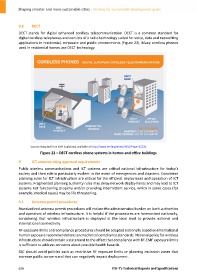Page 638 - Shaping smarter and more sustainable cities - Striving for sustainable development goals
P. 638
8.6 DECT
DECT stands for digital enhanced cordless telecommunication. DECT is a common standard for
digital cordless telephones and consists of a radio technology suited for voice, data and networking
applications in residential, corporate and public environments (Figure 22). Many cordless phones
used in residential homes use DECT technology.
Source: Adapted from EMF Explained, available at http://www.emfexplained.info/?Page=25533
Figure 22 – DECT cordless phone systems in homes and office buildings
9 ICT antenna siting approval requirements
Public wireless communications and ICT systems are critical national infrastructure for today’s
society and their role is particularly evident in the event of emergencies and disasters. Consistent
planning rules for ICT infrastructure are critical for the efficient deployment and operation of ICT
systems. Fragmented planning authority rules may delay network deployments and may lead to ICT
systems not functioning properly and/or providing intermittent service, which in some cases (for
example, medical cases) may be life threatening.
9.1 Antenna permit procedures
Standardized antenna permit procedures will reduce the administrative burden on both authorities
and operators of wireless infrastructure. It is helpful if the procedures are harmonized nationally,
considering that wireless infrastructure is deployed at the local level to provide national and
international connectivity.
RF exposure limits and compliance procedures should be adopted nationally based on international
human exposure recommendations and technical compliance standards. National policy for wireless
infrastructure should contain a statement to the effect that compliance with RF‐EMF exposure limits
is sufficient to address concerns about possible health hazards.
SSC should avoid policies such as restrictive RF exposure limits or planning exclusion zones that
increase public concern and that can negatively impact deployment.
628 ITU‐T's Technical Reports and Specifications

